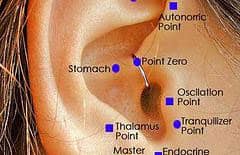
Historical background
Like all other types of acupuncture, the practice of ear acupuncture can be traced back many years ago. Ear acupuncture was practised in ancient Egypt, Greece, Rome and the Mediterranean area.[6] In certain tribes in Arabia, a section of the ear was cauterised with a hot metal probe.[7] Similarly, Alexandre Varille (1909-1951) an Egyptologist, has provided that women who no longer wished to have children had their ears pricked with a needle or cauterised with heat.[8] Mediterranean sailors wore gold earrings for the purposes of decoration and vision improvement.[9] Hippocrates, the father of Greek medicine documented that doctors made small cuts in the veins located behind the ear by way of dealing impotency issues, facilitating ejaculation and relieving leg pain.[10] Clinical reports in Europe during the Renaissance also document the use of ear cauterisations to treat leg pain.[11] In 1810, an Italian professor Ignazio Colla reported that a man stung by a bee in the antehelix was soon after relieved of pain in the legs.[12] In 1850, the French Journal des connaissainces medico-chirurgicales described 13 different cases of sciatic pain which had been treated by cauterising the ear with hot iron, with all but one improving fully.[13]
What is the ear acupuncture process like?
The acupuncturist will use a mixture of normal acupuncture and ear acupuncture. Depending on the condition of the patient, the acupuncturist will choose a couple of acupoints on the ear and then stimulate them for a while. Ordinarily, ear tacks or ear seeds will be inserted into the acupoints as opposed to traditional needles. Ear tacks are smaller versions of traditional needles, but these tacks have an adhesive backing to them. They are placed inside the ear and remain for a couple of days, or possibly a week if the condition is serious. Ear seeds are very tiny seeds which comes from a plant called Vaccaria. They get placed on the acupoints of the ear and are held there with adhesive tape.
What symptoms does ear acupuncture treat?
Ear acupuncture therapy may assist in alleviating the following symptoms: mood disorders, smoking addiction, pain in relation to chronic pain and other addictions (1,2).
Is ear acupuncture safe?
Generally, ear acupuncture is safe but is unsuitable for patients with broken chilblains, infection, ulcer and eczema on the external ear.[14] It is prohibited on patients who are pregnant and who have a history of habitual abortion.[15]
Possible side effects of ear acupuncture
Most commonly, ear infections may occur from poor sterilization which may spread to the ear cartilages and in extreme cases, cause auricle atrophy and abnormality.[16] In the early stage, auricle infection may prevail by red swelling of the local skin accompanied by mild pain.[17] This may be treated by applying 2.5% alcohol to the local skin two to three times a day or by applying ointment for four to five days.[18] Ear infections may be avoided by using sterilised or preferably disposable needles and doing double sterilisation to point areas with iodine tincture and alcohol.[19]
